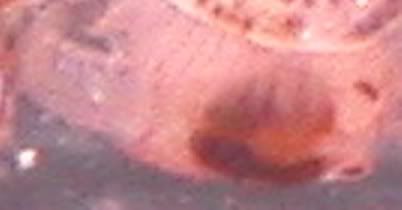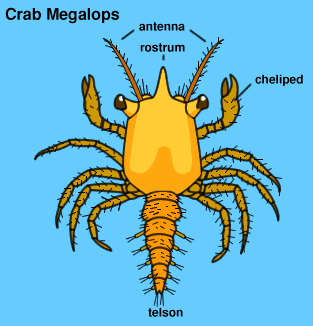Alright...another update...the first larva has hatched. Hooray!



This is turning out to be a successful experiment (knock on wood). I have included two pictures below, one original picture and another one with markings to show where exactly the larva is. Keep in mind that crayfish young/larva are not mobile right after hatching (in contrast to shrimp). They usually cling to the abdomen of the female for a few more days until they get to a mobile developmental stage. Since there is no mother to cling on to, this hatched cray is just lying in the net motionless...but alive.
But first a few comments....
YuccaPatrol wrote:
I think you have this switched up. The eggs start out full of yolk that is dark colored. The clear part is composed of the cells of the developing embryo. When they hatch, the larval stages are mostly clear with only a small amount of dark yolk remaining.
Of course you're right. That makes a lot more sense than the "white yolk" getting bigger over time...I should not post when I am dead tired in the middle of the night...LOL.

However, at this stage there does not seem to be much, if any, yolk left. As you will see in the pictures below, the white part is the body and the dark part is the head of the larva. There may be a yolk sack still attached to the larva, but without a microscope it's going to be hard to prove. In the egg all the way at the bottom of the picture you see what appear to be two eyes.
Your photos do show that development is progressing very normally. All of the eggs look good and I am impressed with the potential yield. (Of course, don't count your crays until they hatch, but these look great!

)
The yield is actually higher than it seems. You always only see part of the eggs in the net as I am focusing as close as it is possible with my macro lens. There are right now about 31 eggs and one hatched larva in the net. In the beginning I thought I had only about 30 eggs...but apparently I had more since about 4-6 eggs fungused and were thrown away.
Here are the pictures..they should be self-explanatory:













